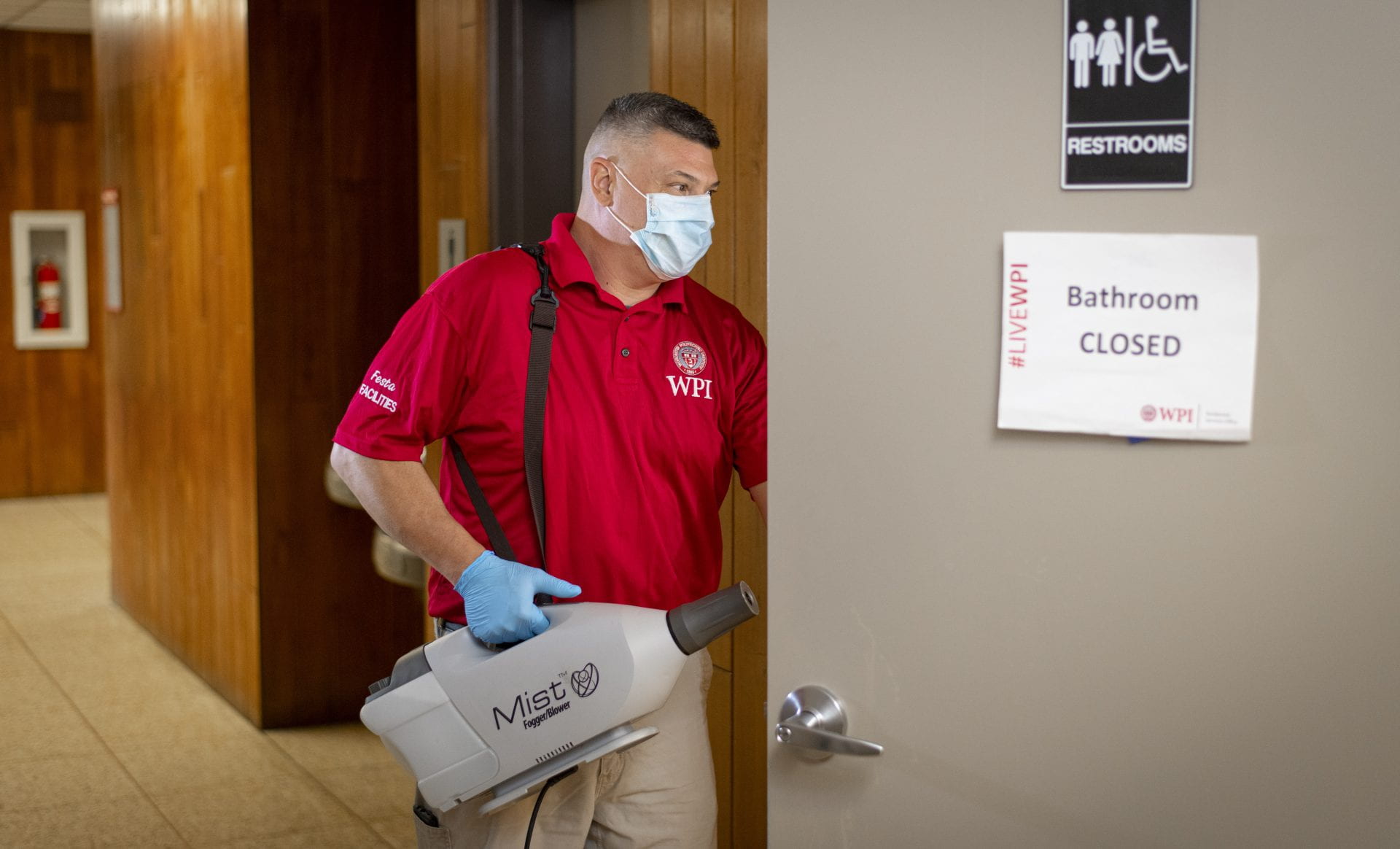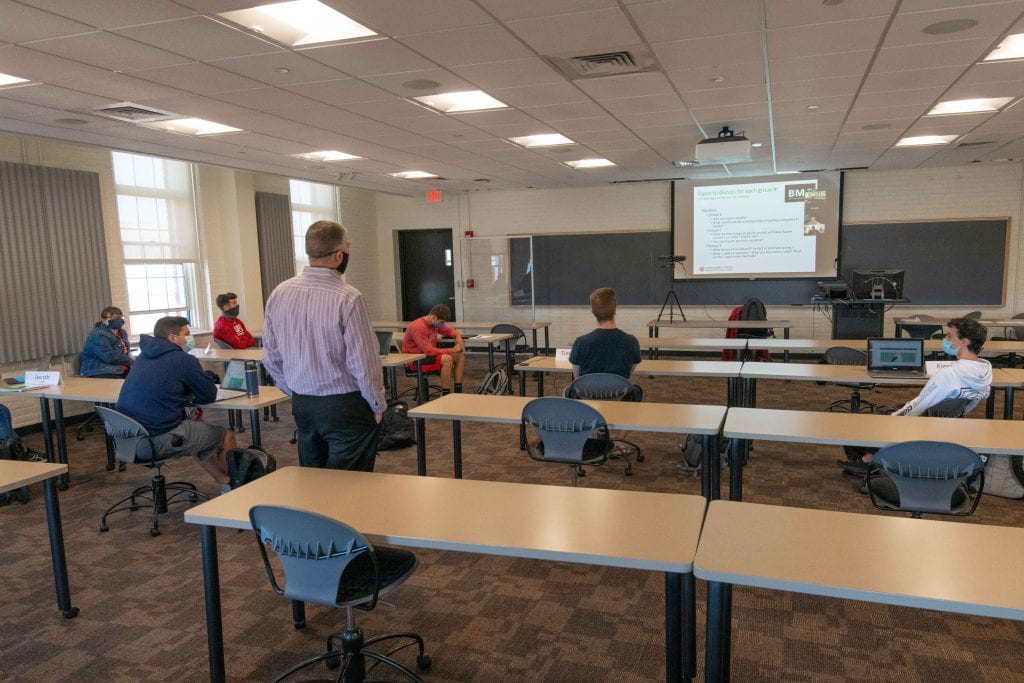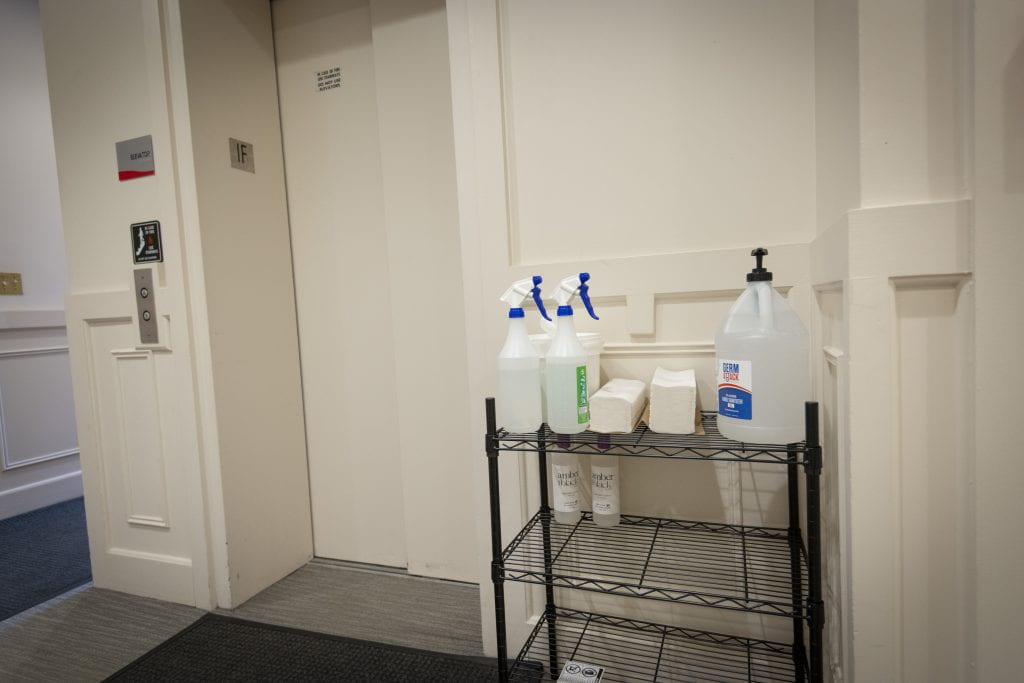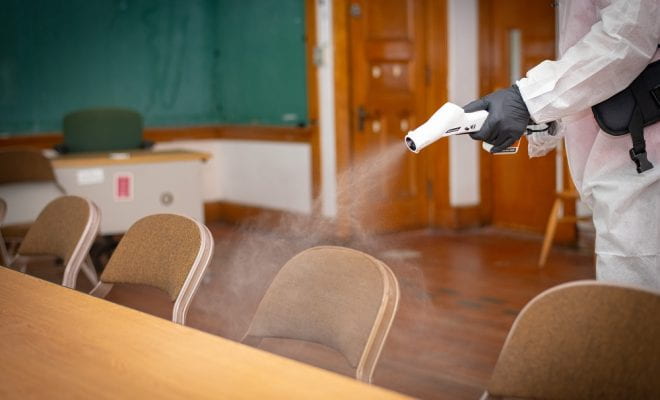From the start, work on guidelines and plans for keeping the campus and its nearly 7,000 students and more than 1,700 faculty and staff members as safe as possible was one of the highest priorities for CERT (the Coronavirus Emergency Response Team).
To achieve that goal, Eric Beattie, vice president for campus planning and facilities management, turned to his 102-member campus operations team, which includes grounds, custodial, the trades and power plant, design and construction, environmental health and safety, campus events, and campus planning. Each of these experts in their respective fields contributed in many ways.
While most of the WPI community left campus in March 2020 after Governor Baker’s decision to shut down the state, some students could not go home. For Beattie’s team, “Job one was to help keep those who remained safe, following guidance from the CERT experts, which, in turn, were based on federal and state guidelines.”
The fact that WPI is a technical school definitely had an impact on the success of our efforts. Its leadership, academic and research staff, and Board of Trustees are scientists, engineers, and problem solvers who worked hard to make the best decisions regarding the safety of our campus community.
Eric Beattie, Vice President for Campus Planning and Facilities Management
Beattie found confidence in the experts the university had at its disposal. “The fact that WPI is a technical school definitely had an impact on the success of our efforts,” he says. “Its leadership, academic and research staff, and Board of Trustees are scientists, engineers, and problem solvers who worked hard to make the best decisions regarding the safety of our campus community.”
What is usually a behind-the-scenes operation took center stage as the campus response to the pandemic quickly rallied to implement a variety of safety measures.
Driven by directives from CERT, Beattie, as the department’s lead on the team, helped set the parameters for an on-campus experience. “Our initial goal was to de-densify the campus by removing tables, chairs, and other furniture items,” he says. “We also installed signage to inform those who remained on campus about pandemic protocols, and added protective barriers in places where face-to-face interaction was necessary.”
The signage consisted of more than 2,000 floor stickers, wall signs, and banners designed and produced in conjunction with the Marketing Communications Department. Between 200 and 300 clear plastic Lexan barriers were installed, including at the front desks in Gordon Library and the Sports and Recreation Center.
Also among those first steps was getting PPE (personal protective equipment) and cleaning supplies in place. But with a worldwide shortage of face coverings, disinfecting wipes, hand sanitizer, cleaning products, and other important supplies, that proved challenging. At the height of the shortage, Facilities purchased products from wherever they could be found to piece together a small cache as a disrupted supply chain was caught short-handed. As PPE supplies became more available, the department maintained a three-month supply with a plan to draw down those reserves when the pandemic began to wane.
As a result of the initial shortage, employees were responsible for their own PPE in the early months of the pandemic. But by autumn, the university was able to supply employees and students with the products they needed. The Facilities team also created supply stations in each of the 91 buildings under its management. Thousands of items had to be ordered to stock these stations, which were located in entry ways, in every classroom, and on every floor of nearly every building.
For the most part, this work required the Facilities management team to be on campus. To do so safely, the team developed a rotating work schedule that allowed for appropriate social distancing between co-workers even as the team completed an increased number of work responsibilities.
From March to May 2020, Beattie worked from home while Ron O’Brien, director of facilities, whose work focused on the physical plant, was stationed on campus. Over the summer, when the university decided to bring students back for the start of A-Term, with all students having the option of attending classes in person, remotely, or with a hybrid of the two, the work of preparing the physical campus became intense, and the Facilities team employed external contractors during the summer to ensure that everything would be ready in time.
“HVAC systems were modified to increase fresh air intake and high-efficiency filters were installed to enhance air quality,” O’Brien says. “Sanitation protocols underwent changes to make them more robust, and bathrooms, elevators, and other small spaces were operated at reduced capacities with intensive regular cleaning.”
In addition, pedestrian patterns were altered to create one-way traffic. Doors were marked as entry- or exit-only, and stairways and elevators were adapted with code compliance and safety considerations at the forefront of the planning. Floor stickers reminded people to stay six feet apart and provided directional instructions for pedestrians.
With students scheduled to return the third week of August 2020, and classes slated to begin on the 28th, the team needed to downsize classrooms to no more than 40 percent of capacity to comply with the recommended six feet of distance. For very large classes, instruction would happen remotely, with small working groups able to meet in person on campus.
To create the requisite six feet of distance inside classrooms, desks and chairs were removed, a massive effort accomplished by Facilities staff. O’Brien converted a WPI building on Sagamore Road into a storage space for the desks, chairs, and other furniture removed from campus buildings. “Hundreds of pieces of classroom furniture were removed to create enough space to allow for social distancing,” he says, “Because of its extensive array of buildings, we were able to use space that the university already owned.”
The Facilities team worked closely with Residential Services to find ways to create more student housing in order prepare isolation spaces for students who tested positive for COVID-19 and quarantine spaces for those who had been exposed to the virus.
They turned to the WPI townhouses, a complex of 108 units, about 60 percent of which were slated to be removed to make way for a new residence hall. With that project on hold, 65 units were quickly prepared for use as isolation and quarantine spaces. Students who needed to use these units were tended to and supplied with clean linens and food delivered to their doors by the university’s health and residential services teams.
Using data and determining the capacity at which they could safely care for ailing or exposed students, CERT established a threshold of 75 percent of the quarantine and isolation units. In other words, if roughly 48 units became occupied, it would trigger a different protocol for the campus community, one requiring a lockdown, among other restrictions. Fortunately, that threshold was never reached.
Anticipating the need to treat students with COVID-19–related symptoms, and wanting to keep those cases separated from students seeking routine medical care, WPI’s Health Services facility became a dedicated COVID-19 treatment center. Another location was identified and quickly renovated to create an annex where providers could care for non-COVID-19 cases. This separation, combined with intensive contact tracing, helped mitigate the spread of COVID-19 on campus.
The cost of renovations, signage, PPE supplies, cleaning equipment, and overtime were significant, but judging by the results, it was worth it. No member of the on-campus community was lost to the pandemic, and for that, the entire team is breathing a sigh of relief (though music professor Joe Policelli was infected while off-campus and passed away in April 2020). A safe and enriching academic experience was the outcome of the hard work of the Facilities staff, who labored side-by-side with many other departments to create a united team. WPI, known for its project-based, immersive style of learning, stepped up to the challenge and tackled the coronavirus project as if lives depended on it—which they did.
O’Brien says there were positive outcomes of the pandemic, not the least of which was the discovery of just how nimble the WPI workforce can be. “Our ability to work from home was enhanced by the IT department’s rerouting of our phone calls,” he says. “Because we could take calls on our laptops, we could address issues with little to no delay. It was amazing to watch how WPI leadership made rational, bold decisions, such as holding in-person classes, which were backed by science.
“Some members of the community will continue to work remotely,” O’Brien adds. “So this option will help keep some of our staff at home during off hours, when possible, but still get the job done. We are a team of doers and we will always figure out a way. I am extremely proud of all that our team accomplished.”











